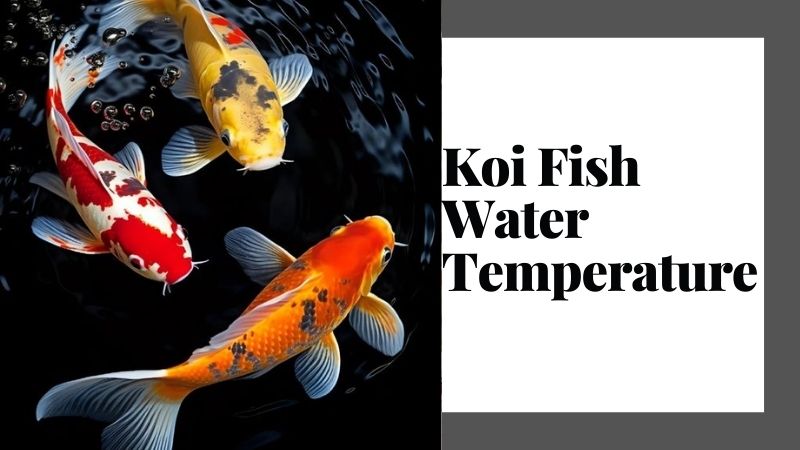Maintaining the ideal water temperature is crucial for the health and happiness of your koi fish. These majestic carp are surprisingly adaptable, but their comfort and activity level depend heavily on the water’s warmth. In the article Tropical Fish Haven wil llearn about Koi Fish Water Temperature, explaining how it affects their biological function and overall health.
Origin and Habitat of Koi Fish
Koi fish have a fascinating history dating back to the 19th century, when Japanese farmers began selectively breeding carp to enhance their colors and patterns. Originally native to freshwater environments, these fish can thrive and grow to impressive sizes, reaching up to 3 feet in length under optimal conditions.
Fish metabolism and activity are closely tied to water temperature. Therefore, maintaining stable water temperatures throughout the year is essential to provide an optimal habitat for omnivorous fish.
Koi Fish Water Temperature
Koi fish are known for their remarkable adaptability to various temperature ranges. Experts suggest that these resilient fish can survive in temperatures as low as 1°C (34°F) and as high as 30°C (86°F), although these extremes are not ideal for their well-being.
Primarily cold-water inhabitants, koi thrive best within a narrower temperature range of approximately 15°C to 25°C (59°F to 77°F). Within this optimal range, koi exhibit their best health and vitality, ensuring they can comfortably engage in their natural behaviors and maintain overall well-being. Temperature fluctuations outside of this range can stress the fish and potentially lead to health issues, underscoring the importance of providing stable and appropriate water conditions for koi in captivity.
Koi Fish and Extreme Weather
Koi fish, known for their resilience, face significant challenges in extreme weather conditions. Here are some effects on koi fish when water temperatures stray too far from their ideal range:
Immune system
Koi fish thrive best when water temperatures are around 15°C, as this temperature range supports their immune system’s optimal function. In colder temperatures, pathogens in the water become more active, posing a greater risk of parasitic infections. During winter, the weakened immune response of koi fish makes them more vulnerable to illness.
Warmer water temperatures can lead to an increase in harmful algal blooms. These algae produce toxins that can adversely affect koi fish, leading to various diseases and health issues.
Higher water temperatures accelerate the dissolution of ammonia, a waste product excreted by fish. Elevated ammonia levels can be toxic to koi fish, impairing their health and well-being. Additionally, warmer water holds less oxygen, which is crucial for the fish’s respiration. Oxygen depletion in warmer temperatures can stress koi fish and weaken their overall vitality.
Digestion
As water temperatures decrease, the internal systems of koi fish slow down, leading to reduced feeding activity. During this period, any food remaining in the digestive system can linger longer, potentially causing it to decompose and leading to serious health issues or even death for the fish. It’s crucial to monitor their feeding habits and adjust accordingly to ensure their digestive health during colder seasons.
Regulating Koi Pond Water Temperature
The health and feeding behavior of koi fish are significantly influenced by water temperature. When temperatures are within the ideal range of 15°C to 25°C, koi experience optimal metabolic activity. However, as temperatures exceed 28°C, bacterial activity increases, which can adversely affect their environment.
Higher water temperatures also impact oxygen levels and the dissolution of potentially harmful compounds such as ammonia. Oxygen availability in water is crucial for various processes essential to the activity, growth, and overall health of koi fish in their pond habitat. Thus, maintaining appropriate water temperature levels is essential to ensuring the well-being and vitality of koi fish.
Extreme temperatures can significantly impact the health and survival of koi fish. Therefore, it’s essential to manage water temperature carefully in ponds and tanks to ensure the safety and well-being of the fish. Using a dependable pond thermometer is crucial for monitoring any fluctuations in water temperature that could potentially endanger the inhabitants of your koi fish pond. This proactive approach helps maintain stable and suitable conditions to support the health and longevity of your koi.
Protecting Koi Fish During Summer
During hot summer weather, koi fish are vulnerable to issues like oxygen depletion and heightened disease susceptibility. Here are some practical tips to help keep your koi pond cool and healthy:
Change Water Frequently
Changing the water frequently helps to maintain cooler pond water during the summer months. Warmer water can increase the likelihood of illness in koi fish. By replacing approximately 10 percent of the pond water, you can improve aeration and regulate temperatures to optimal levels. Effective pond water circulation practices include:
Drain the pond
Given the sensitivity of koi fish, it is advisable to perform small and frequent water changes. This approach allows the fish adequate time to acclimate to the new water conditions.
For changing the water, using a pond vacuum is the most convenient method, while larger ponds may benefit from submersible or external pumps.
Dechlorinate water before refilling the pond
Before refilling the pond with mains water, it is essential to treat it for chloramine and chlorine, as these compounds can be harmful to the pond ecosystem. One effective method is to install an activated carbon catalyst at the end of the hose to remove these compounds as the water flows into the pond.
Compensate for lost nutrients
After completing a water change, beneficial bacteria and essential nutrients are typically depleted. To replenish these, it’s recommended to add koi clay to the pond water immediately after refilling.
Furthermore, it’s important to test the water parameters post-change, focusing on nutrients and temperature levels, to ensure they are conducive to the health of the koi fish and the overall pond environment.
Shade the Pond
Reducing UV exposure can help maintain a cooler temperature in a koi pond. One effective method is to use a porch umbrella to provide artificial shade.
Another natural approach is to introduce floating pond plants such as water hawthorn, blue flag, marsh marigold, and horsetail. These plants not only create shade but also enhance oxygen levels within the pond.
Circulate the Pond Water
To prevent water from becoming stagnant and overheating, utilize a bubbler, waterfall, or water jet to keep the water circulating throughout the pond.
Add Ice to The Pond
Surprisingly effective in hot climates, adding ice to the pond can help regulate water temperature. Depending on the pond’s size, adding a gallon or half-gallon of ice is a simple and cost-effective method to cool the water down.
Increasing Pond Depth
Shallow ponds are more susceptible to excessive sunlight during summer months compared to deeper ponds. They also tend to evaporate more quickly due to the intense summer heat.
To prepare for hot weather, consider relocating koi to create space for deepening the pond.
During summer, avoid overfeeding fish. Uneaten food decays faster in warm water, leading to elevated levels of toxic ammonia that can harm or kill fish.
Regularly clean the pond during summer to remove dried leaves and plants, which also contribute to ammonia levels. Installing a skimmer system can help keep the pond free from debris that produces ammonia.
Keeping Koi Pond Warm During Winter
Preserve Ice and Snow on the Pond Surface
Allowing snow and ice to remain on the pond’s surface during winter is not detrimental to koi. In fact, it acts as an insulating layer that shields the water from harsh winds and prevents rapid temperature fluctuations.
In regions with colder winter climates, it’s beneficial to maintain this ice cover while ensuring there’s a hole for gas exchange.
Use a Pond Cover
Covering the pond serves multiple purposes: it acts like a greenhouse, trapping warmth and maintaining stable water temperatures. As the water absorbs heat during the day, the cover prevents heat loss at night, preventing drastic temperature swings.
Additionally, a pond cover shields the water from cold winds. Some koi keepers opt for a floating plastic sheet to create a barrier against chilly air and help retain warmth in the pond.
Consider using a solar cover in conjunction with an air pump to further prevent freezing and maintain a favorable pond environment.
Consider using a Pond Heating System
A pond heating system is the most efficient method for warming pond water. Various heating systems are available, each suited to different water volumes and heating capacities.
Inline Boilers
Inline boilers efficiently circulate warm water from heating chambers throughout the entire pond. This consistent heating process helps prevent the pond water from freezing.
Pond De-Icer
A more economical option compared to inline boilers, a pond de-icer floats on the pond’s surface. While it doesn’t evenly warm the water, it effectively creates a hole in the pond’s surface to allow gas exchange.
For larger ponds with many fish or water plants, multiple de-icers may be necessary to ensure effective coverage.
Disable Water Cooling Features
Turn off water-cooling features such as pumps, filters, and fountains during winter. These devices expose pond water to cold air and winds, causing temperatures to plummet. Running these features can increase the likelihood of the pond freezing over.
Use an Air Pump
Running an air pump is a cost-effective alternative to using a boiler. It helps degas the pond and maintains a hole in the ice to prevent complete freezing. Additionally, the circulation of oxygen by the pump supports the fish’s survival through the colder months.
Transfer Koi to a Fish Tank
Moving koi to a fish tank or indoor pond is a viable option for smaller fish populations. Ensure the tank has temperature control features or use an aquarium heater to match the water temperature from the pond. The temperature difference between the pond and the tank should ideally be less than 10 degrees Fahrenheit to minimize stress on the fish.
Deepen Your Pond
Although labor-intensive, deepening your pond is beneficial as deeper water is less likely to freeze entirely. Aim for a pond depth of at least 4 feet to provide a warmer refuge for koi during winter. This depth allows the fish to find a comfortable area away from surface predators like raccoons.
While koi can endure extreme temperatures, they are not comfortable in cold water. Complete freezing of the pond can lead to fish fatalities, as they require access to the surface to breathe. Adequate preparation, including ensuring the pond remains partially ice-free and clearing organic matter like leaves and plants before winter, is crucial for the fish’s well-being.
Conclusion
By understanding how water temperature affects koi, you can create a thriving environment for them. Monitoring and adjusting the temperature as needed, especially during seasonal shifts, helps ensure your koi remain active, healthy, and display their vibrant colors for years to come.





